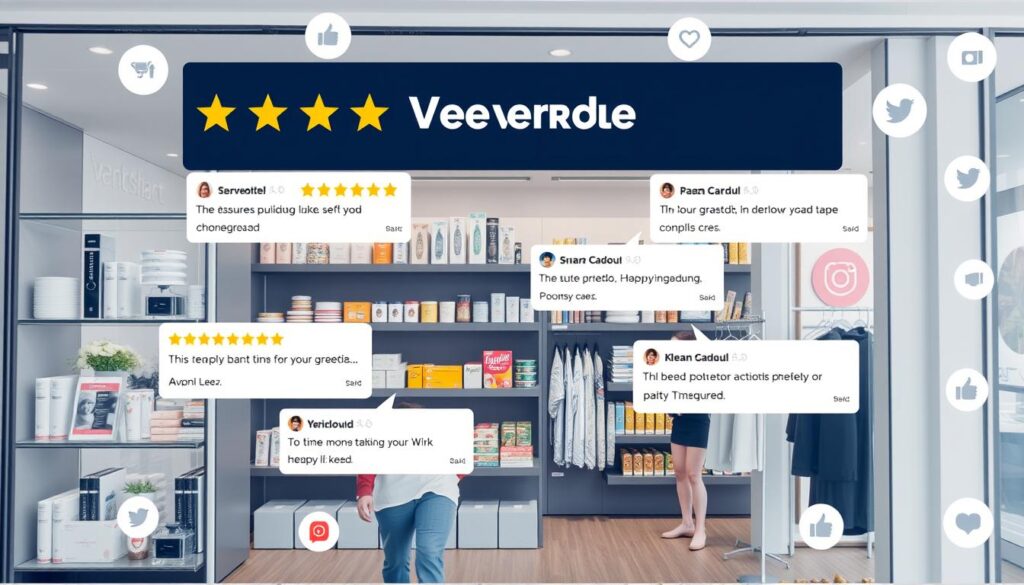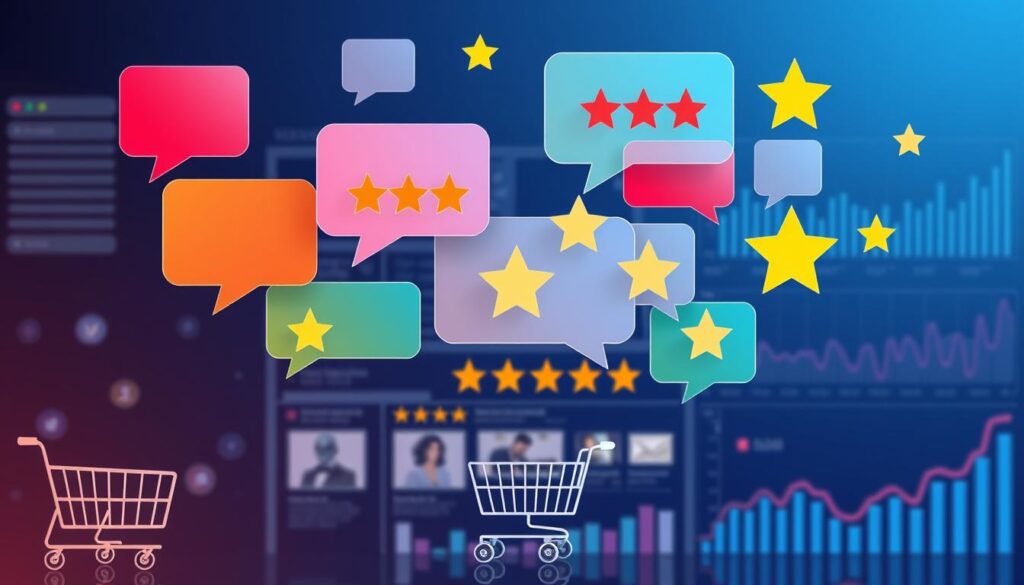Building a loyal customer base is crucial for the success of any eCommerce business. With the global loyalty management market projected to expand from $5.57 billion in 2022 to $24.44 billion by 2029, it’s clear that eCommerce customer loyalty is a key factor in driving growth. In this guide, we’ll explore strategies to foster online store customer retention and transform one-time buyers into devoted brand advocates.
Up to 80% of eCommerce business profits come from 20% of repeat or returning customers, highlighting the importance of prioritizing customer loyalty. Unfortunately, only 32% of business owners make retaining customers a priority, despite the significant impact it can have on their bottom line. By focusing on eCommerce customer loyalty and online store customer retention, businesses can drive sustainable growth and stay ahead of the competition.
Table of Contents
Key Takeaways
- Up to 80% of eCommerce business profits come from 20% of repeat or returning customers
- Only 32% of business owners prioritize retaining customers as a priority
- eCommerce customer loyalty is a key factor in driving growth and online store customer retention
- Personalized experiences and data-driven insights can help transform one-time buyers into devoted brand advocates
- Building a loyal customer base can drive sustainable growth and stay ahead of the competition
- A 2022 survey found that 79% of US consumers purchased more frequently from a brand because they participated in a loyalty program
Understanding Customer Loyalty in Digital Commerce
Customer loyalty is a crucial aspect of digital commerce, as it can significantly impact a brand’s financial growth and reputation. In the digital realm, digital customer loyalty refers to the tendency of customers to repeatedly purchase from a particular brand or website. This loyalty is often driven by factors such as great value, personalized experiences, and exceptional customer service.
According to recent statistics, just 8% of loyal customers can generate 41% of an e-commerce store’s revenue, highlighting the immense value of eCommerce repeat customers. Moreover, 44% of customers remain loyal to brands that offer great value, while 71% have switched brands at least once in the past year, showing the fickle nature of customer loyalty in the e-commerce sector.
Some key metrics for measuring customer loyalty include customer retention rates, purchase frequency, and average order value. By tracking these metrics, businesses can gain valuable insights into their customers’ behavior and preferences, allowing them to tailor their marketing strategies and improve customer satisfaction.
| Statistic | Value |
|---|---|
| Loyal customers’ revenue contribution | 41% |
| Customers loyal to brands offering great value | 44% |
| Customers who have switched brands in the past year | 71% |
By understanding the importance of digital customer loyalty and eCommerce repeat customers, businesses can develop effective strategies to foster loyalty and drive long-term growth in the competitive e-commerce market.
Creating a Strong Foundation for Customer Relationships
Building strong customer relationships is crucial for eCommerce businesses, as it leads to increased customer retention and loyalty. Customer relationship building is about creating a connection with your customers, understanding their needs, and delivering personalized experiences. According to a study by Epsilon, 80% of consumers are more likely to make a purchase when brands offer personalized experiences.
A study by Bain & Company reveals that increasing retention by as little as 5 percent can boost profits by as much as 95 percent. This highlights the importance of eCommerce customer trust and loyalty in driving business success. By focusing on customer relationship building and delivering exceptional customer experiences, businesses can increase customer retention and loyalty, ultimately leading to increased sales and revenue.
Some key strategies for building strong customer relationships include:
- Personalization: tailoring the customer experience to individual needs and preferences
- Consistent communication: keeping customers informed and engaged through regular updates and notifications
- Delivering on promises: meeting customer expectations and exceeding them whenever possible
By implementing these strategies and focusing on eCommerce customer trust, businesses can create a strong foundation for customer relationships, leading to increased loyalty, retention, and ultimately, business success.
Essential Elements of Customer Experience Design
A well-designed eCommerce website is crucial for providing a positive eCommerce user experience. This involves creating an intuitive and user-friendly interface that makes it easy for customers to navigate and find what they are looking for. A Forrester Research study found that a well-designed user interface could raise a website’s conversion rate by up to 200%, and a better UX design could yield conversion rates up to 400%.
Key elements of effective customer experience design include website navigation and usability, mobile optimization strategies, and payment and checkout optimization. By focusing on these essential elements, businesses can create a smooth and enjoyable shopping experience that encourages customers to return.
Website Navigation and Usability
A clear and simple website navigation is vital for online store usability. This can be achieved by using clear and concise language, minimizing the number of clicks required to complete a task, and providing easy access to important pages such as the shopping cart and checkout.
Mobile Optimization Strategies
With the growing importance of mobile commerce, businesses must ensure that their website is optimized for mobile devices. This includes using responsive design, optimizing images and content for faster loading times, and providing a seamless and intuitive user experience.
Payment and Checkout Optimization
The payment and checkout process is a critical part of the eCommerce user experience. Businesses can optimize this process by providing clear and concise information, minimizing the number of steps required to complete the checkout process, and offering secure and trusted payment options.
| Element | Importance |
|---|---|
| Website Navigation and Usability | High |
| Mobile Optimization Strategies | High |
| Payment and Checkout Optimization | High |
Personalization Strategies That Drive Loyalty
eCommerce personalization is a powerful tool for building customer loyalty. By offering a customized shopping experience, businesses can increase customer engagement and sales. According to recent statistics, 80% of shoppers are more inclined to buy from a brand that offers a tailored experience, and 90% of respondents are interested in personalized offers based on their browsing and purchase history.
A well-executed eCommerce personalization strategy can include personalized product recommendations, targeted marketing campaigns, and customized content. By leveraging customer data, businesses can create a unique experience for each customer, increasing the likelihood of loyalty and retention. Some key statistics that support the importance of eCommerce personalization include:
- 77% of customers are likely to stay with a brand that rewards their loyalty
- 67% of consumers expect personalized experiences as a standard of service
- 89% of business leaders believe that personalization will be valuable to their business success in the next three years
By implementing effective eCommerce personalization strategies, businesses can increase customer engagement, sales, and loyalty. As the statistics show, customers are more likely to return to a brand that offers a tailored experience, and businesses can expect to see an increase in customer engagement and sales with effective utilization of customer data.
How to Build a Loyal Customer Base for Your eCommerce Business Through Service Excellence
Providing exceptional eCommerce customer service is crucial for building a loyal customer base. According to the 2017 Microsoft State of Global Customer Service report, customer service impacts brand choice and loyalty for 96% of consumers worldwide. By prioritizing service excellence, you can create positive experiences that encourage customers to return and recommend your brand to others.
Effective online store support is essential for resolving issues and creating a positive experience. Some key strategies for achieving this include:
- Implementing multi-channel support to ensure customers can reach you through their preferred platforms
- Optimizing response times to ensure timely resolutions
- Training support teams to handle inquiries with empathy and efficiency
Customer Support Best Practices
Customer support best practices are critical for building trust and loyalty with your customers. This includes providing personalized support, offering hassle-free returns, and ensuring that customers can easily contact you through their preferred channels.
Response Time Optimization
Response time optimization is vital for ensuring that customer inquiries are addressed in a timely manner. This can be achieved by implementing efficient processes, training support teams, and leveraging technology to streamline communication.
| Support Channel | Average Response Time |
|---|---|
| 2-4 hours | |
| Live Chat | 1-2 minutes |
| Phone Support | 1-2 minutes |
Multi-Channel Support Implementation
Multi-channel support implementation is essential for ensuring that customers can reach you through their preferred platforms. This includes email, live chat, phone support, and social media. By providing multiple channels, you can increase customer satisfaction and loyalty.
Implementing an Effective Loyalty Program
A well-designed loyalty program can be a game-changer for your eCommerce business. With eCommerce loyalty programs, you can increase customer retention rates, driving repeat purchases and fostering long-term loyalty. According to a study by Accenture, increasing customer retention rates by just 5% can increase profits by 25% to 95%.
There are various types of loyalty programs, including points-based, tiered, and subscription-based programs. For example, Amazon Prime, a subscription-based loyalty program, has attracted 148.6 million Prime members in the US alone, generating over $25 billion in subscription fees. When designing a loyalty program, it’s essential to consider the reward structure, ensuring it’s enticing and motivates customers to engage more with your brand.
Some key elements to consider when implementing an online store rewards program include:
- Reward structure design
- Program measurement and optimization
- Customer experience and engagement
By implementing an effective loyalty program, you’ll give your customers a compelling reason to choose your store over competitors, driving repeat purchases and fostering long-term loyalty. With the right strategy, eCommerce loyalty programs can help you increase customer lifetime value and stay ahead in the competitive eCommerce market.
Email Marketing Strategies for Customer Retention
Email marketing remains a crucial tool for customer retention in eCommerce, offering a cost-effective way to nurture relationships and encourage repeat purchases. By leveraging eCommerce email marketing strategies, businesses can stay top-of-mind with their customers and drive revenue growth. For instance, loyal customers spend 67% more than new consumers, demonstrating the value of existing customers.
Effective customer retention emails are personalized, timely, and relevant, providing customers with special offers, educational content, and personalized recommendations. Segmentation of the customer base is key to creating targeted emails that resonate with specific groups, such as new customers or high spenders. By using data to tailor messages, businesses can increase engagement rates and prompt customers to take action.
Some key strategies for eCommerce email marketing include:
- Creating engaging subject lines to grab recipients’ attention
- Using clear and compelling calls to action (CTAs) to prompt action
- Implementing automated email flows, such as new customer and winback email series
- Providing personalized recommendations and incentives to encourage repeat purchases
By incorporating these strategies into their customer retention emails, businesses can improve customer retention rates, reduce churn, and drive revenue growth. With 59% of customers saying marketing emails influence their purchase decisions, the impact of effective email marketing on customer retention is undeniable.
Social Proof and Trust Building
Building trust is crucial for fostering customer loyalty in eCommerce. One effective way to achieve this is by leveraging social proof, which can increase average order value by encouraging further purchases in the checkout process. For instance, highlighting how many people have purchased a product can influence potential buyers, with 84% of people trusting online reviews as much as personal recommendations.
Real-time sales notifications showcasing recent purchases create a sense of trust and increase credibility. Social proof elements like reviews and testimonials are among the most effective ways to increase conversion rates in eCommerce. In fact, online stores with at least five reviews are more likely to lead to higher conversion rates, with the optimal number of reviews being between 20 and 50.
Displaying customer reviews prominently on product and landing pages can build trust and reliability. Additionally, showcasing both high and low ratings can increase credibility and transparency in customer reviews and testimonials. Security certifications displayed through trust seals from trusted third-party organizations can also signal to customers that the website is secure for shopping, providing essential online store trust signals.
By incorporating eCommerce social proof and online store trust signals, businesses can create an environment where customers feel secure and confident in their decision to shop repeatedly. This can be achieved through various strategies, including:
- Encouraging customers to share their experiences and fostering brand advocacy and loyalty
- Partnering with influencers or industry experts to enhance the perceived quality and value of products
- Integrating social media feeds directly into the website to offer real-time engagement and content from satisfied customers
By implementing these trust-building tactics, businesses can increase conversion rates, attract new customers, and ultimately drive long-term growth and success.
Post-Purchase Communication Strategies
Effective eCommerce post-purchase communication is crucial for building customer loyalty and encouraging repeat business. By implementing strategic order follow-up strategies, businesses can enhance the overall customer experience and reduce anxiety. According to Hubspot, repeat customers spend 67% more on average compared to new customers, highlighting the importance of post-purchase communication.
A well-structured post-purchase communication plan includes order confirmation optimization, shipping updates and tracking, and follow-up sequences. These elements work together to provide customers with a seamless and informative experience. For instance, a study by Shopify found that customers who make repeat purchases have a higher lifetime value compared to one-time customers.
Some key strategies for effective post-purchase communication include:
- Providing clear and timely shipping updates
- Implementing efficient return handling processes
- Seeking feedback and addressing issues promptly
By mastering these strategies, businesses can increase customer satisfaction and loyalty, ultimately driving long-term growth and success.
Additionally, using messaging channels for customer service can provide a convenient and efficient way to communicate with customers. With 42% of customers preferring messaging apps over other channels, businesses can leverage this trend to enhance their post-purchase communication.
| Channel | Preference |
|---|---|
| Messaging Apps | 42% |
| 26% | |
| Phone | 22% |
Leveraging Data Analytics for Customer Insights
Understanding customer behavior is crucial for businesses to stay ahead in the competitive market landscape. By leveraging eCommerce data analytics, companies can analyze trends, patterns, and correlations to predict customer preferences and needs. This information can be used to create personalized marketing strategies, leading to higher customer satisfaction, increased loyalty, and greater business success.
One of the key benefits of customer behavior insights is the ability to segment the customer base, personalize marketing efforts, and improve overall customer satisfaction. For instance, businesses can use data analytics to identify customer preferences, predict future purchases, and enhance the shopping experience. By doing so, they can tailor their products and services to meet customer needs, ultimately driving sales and building lasting customer relationships.
Some of the ways businesses can leverage data analytics include:
- Analyzing transaction data to understand customer behavior and preferences
- Using predictive analytics to forecast future customer actions
- Implementing personalized marketing strategies based on data insights
By harnessing the power of data analytics, companies can create meaningful interactions with customers and foster long-lasting relationships. For more information on how to leverage data analytics for customer insights, visit this resource to learn more about optimizing your eCommerce business.
By following these strategies and leveraging the power of data analytics, businesses can gain a deeper understanding of their customers and create targeted marketing campaigns that drive results.
| Benefits of Data Analytics | Description |
|---|---|
| Improved Customer Satisfaction | Personalized marketing strategies lead to higher customer satisfaction |
| Increased Loyalty | Data-driven insights help businesses tailor products and services to meet customer needs |
| Greater Business Success | Targeted marketing campaigns drive sales and build lasting customer relationships |
Creating Memorable Unboxing Experiences
The eCommerce unboxing experience is a crucial aspect of online shopping, as it provides customers with a tangible interaction with a brand. A well-designed unboxing experience can lead to increased customer loyalty and positive reviews. In fact, 40% of online shoppers would share an image of their purchase on social media if it came in branded packaging, according to Dotcom Distribution.
When it comes to creating a memorable unboxing experience, there are several key elements to consider. These include packaging design principles, insert marketing strategies, and brand storytelling through packaging. By incorporating these elements, online stores can create a unique and engaging experience for their customers, setting themselves apart from competitors and building a loyal customer base.
Packaging Design Principles
Packaging design is a critical aspect of the unboxing experience. Custom packaging designs can elevate the experience, making it more memorable and shareable. For example, Tiffany & Co.’s iconic robin’s egg blue jewelry boxes have become synonymous with their brand values, showcasing the power of a well-designed unboxing experience.
Insert Marketing Strategies
Insert marketing strategies, such as including free samples or personalized notes, can significantly enhance the customer experience and potentially lead to future sales. These strategies can also encourage customers to share their experience on social media, creating a cost-effective marketing opportunity.
By incorporating these strategies and focusing on creating a memorable unboxing experience, online stores can increase customer loyalty and drive repeat business. As Yotpo reports, 37% of customers say it takes at least five purchases to consider themselves ‘loyal’ to a brand, highlighting the importance of a well-designed unboxing experience in building long-term customer relationships.
| Element | Importance |
|---|---|
| Branded boxes | High |
| Unique packaging materials | Medium |
| Product presentation | High |
| Free samples | Medium |
| Customized sentiments | Low |
By prioritizing these elements and creating a memorable unboxing experience, online stores can differentiate themselves and build a loyal customer base, driving long-term success in the competitive eCommerce market.
Customer Feedback Implementation Systems
Collecting and acting on eCommerce customer feedback is crucial for online store improvement strategies. By gathering feedback through surveys, social media, and reviews, businesses can identify areas for improvement and make data-driven decisions. This helps to build trust and loyalty with customers, ultimately driving long-term growth.
Some effective methods for collecting customer feedback include:
- Implementing a review system on the website
- Using social media listening tools to monitor customer conversations
- Conducting regular surveys to gather feedback and insights
By analyzing customer feedback and implementing changes, businesses can demonstrate their commitment to customer satisfaction and online store improvement strategies. This, in turn, can lead to increased customer loyalty and retention. As customers feel heard and valued, they are more likely to return and recommend the business to others.
By prioritizing customer feedback and implementing effective systems for collecting and acting on it, businesses can stay ahead of the competition and drive long-term success. This is especially important in the eCommerce space, where customer loyalty is key to driving growth and revenue.
Retention-Focused Content Marketing
Creating a loyal customer base is crucial for the success of any eCommerce business. One effective way to achieve this is through retention-focused content marketing. By developing educational content that adds value to customers beyond products, businesses can position themselves as trusted resources. This approach encourages customers to return not just for purchases, but for information and community as well.
eCommerce content marketing plays a significant role in customer retention. By providing valuable and engaging content, businesses can foster a sense of belonging among their customers. This can be achieved through various means, such as blog posts, videos, and podcasts that offer insights, tips, and solutions to customers’ problems.
Some key strategies for retention-focused content marketing include:
- Developing value-added resources, such as buying guides or care instructions, that enhance the customer experience.
- Creating community-building initiatives that encourage customer engagement and loyalty.
- Utilizing customer retention content to drive repeat purchases and loyalty.
By implementing these strategies, businesses can increase customer retention rates, drive revenue growth, and establish a strong brand presence in the market. Effective eCommerce content marketing is essential for building a loyal customer base and achieving long-term success in the competitive world of digital commerce.
Crisis Management and Customer Recovery
Effective eCommerce crisis management is crucial for maintaining customer loyalty and trust. A crisis can arise from various sources, such as a website outage, product recall, or cybersecurity breach. To mitigate the impact of a crisis, it is essential to have a comprehensive plan in place, including customer recovery strategies that prioritize transparency, empathy, and prompt communication.
A study on crisis management in the eCommerce sector found that companies that effectively manage their customer experience during a crisis saw an increase in customer loyalty by up to 35%. This highlights the importance of having a proactive crisis response plan in place, which can include strategies such as:
- Regular monitoring of customer feedback to maintain trust
- Developing a comprehensive disaster recovery plan and conducting regular drills and simulations
- Implementing effective de-escalation techniques during customer interactions
By prioritizing customer recovery strategies and eCommerce crisis management, businesses can turn potentially negative experiences into opportunities to demonstrate their dedication to customer satisfaction, ultimately strengthening customer loyalty and trust.
Measuring and Optimizing Customer Lifetime Value
To build a loyal customer base, understanding the concept of customer lifetime value (CLV) is crucial. CLV refers to the total value a customer brings to an eCommerce business over their lifetime. Measuring and optimizing CLV is essential for businesses to make informed decisions about customer acquisition and retention strategies.
Key performance indicators, such as purchase frequency and average order value, contribute to CLV. Analytics tools and tracking can help gather and interpret this data. Effective CLV optimization strategies include improving customer retention, increasing average order value, and enhancing the overall customer experience.
Some notable examples of successful CLV optimization include the fashion store Never Fully Dressed, which experienced a 59% increase in member spending and a 64% increase in repeat purchase rates after implementing a loyalty program. By focusing on eCommerce customer lifetime value and CLV optimization, businesses can improve financial stability and encourage repeat purchases over an extended period.
To optimize CLV, businesses can utilize customer segmentation based on CLV data, enabling targeted marketing campaigns to increase customer retention and CLV. By monitoring LTV, businesses can identify early signs of attrition and proactively address customer churn through loyalty programs, improved customer support, and targeted incentives.
Conclusion: Building Long-Term eCommerce Success Through Customer Loyalty
As we’ve explored throughout this article, cultivating a loyal customer base is essential for long-term eCommerce success. By implementing a comprehensive strategy focused on delivering exceptional customer experiences, businesses can foster deep connections and keep their customers coming back time and again.
The key is to view customer loyalty as a continuous investment rather than a one-time fix. It requires a holistic approach, incorporating personalization, loyalty programs, seamless service, and data-driven optimization. When executed effectively, these strategies work together to create a virtuous cycle of repeat business, referrals, and increased Customer Lifetime Value (CLV).
As the eCommerce landscape continues to evolve, staying ahead of the curve and adapting to emerging trends will be crucial. Businesses that prioritize eCommerce success strategies centered on long-term customer loyalty will be well-positioned to thrive in the years to come.
FAQ
What defines customer loyalty in the digital commerce landscape?
Customer loyalty in eCommerce refers to the commitment and repeat business that customers demonstrate towards an online store. It encompasses factors such as repeat purchases, positive word-of-mouth, and emotional attachment to the brand.
Why is the value of repeat customers important for eCommerce businesses?
Repeat customers are highly valuable for eCommerce businesses, as they typically spend more, have a higher customer lifetime value, and are more likely to engage in positive word-of-mouth marketing. Retaining and nurturing a loyal customer base is crucial for sustainable growth.
What are some key metrics for measuring customer loyalty in eCommerce?
Key metrics for measuring customer loyalty in eCommerce include customer retention rate, repeat purchase rate, customer lifetime value (CLV), net promoter score (NPS), and customer satisfaction scores. These metrics provide tangible insights into the health and longevity of your customer relationships.
Why is building strong customer relationships the foundation for loyalty in eCommerce?
In the digital world, building trust and fostering long-term relationships with customers is essential for loyalty. Factors such as transparency, consistent communication, and delivering on promises help create an environment where customers feel valued and committed to the brand.
What are the key elements of effective customer experience design for eCommerce?
Effective customer experience design in eCommerce includes optimizing website navigation and usability, ensuring mobile-friendly experiences, and streamlining the payment and checkout process. These elements work together to create a smooth, enjoyable shopping journey that encourages repeat business.
How can personalization strategies drive customer loyalty in eCommerce?
Personalization strategies, such as tailored product recommendations, targeted marketing campaigns, and customized content, can make customers feel understood and valued. By leveraging customer data, eCommerce businesses can create unique experiences that foster stronger emotional connections and loyalty.
What are the best practices for providing exceptional customer service in eCommerce?
Key customer service best practices for eCommerce include optimizing response times, implementing multi-channel support, and training support teams to handle inquiries with empathy and efficiency. Prioritizing service excellence helps resolve issues and create positive experiences that encourage customer loyalty.
What are the different types of loyalty programs and how can they benefit eCommerce businesses?
Ecommerce businesses can implement various types of loyalty programs, such as points-based systems, subscription models, or tiered programs. These programs provide customers with compelling reasons to engage with the brand more, driving repeat purchases and fostering long-term loyalty.
How can email marketing be leveraged for customer retention in eCommerce?
Email marketing remains a powerful tool for building and maintaining customer loyalty in eCommerce. Strategies such as segmentation, engaging content creation, and personalized automation can help eCommerce businesses stay top-of-mind, nurture relationships, and encourage repeat purchases.
What are the key trust-building elements that can enhance customer loyalty in eCommerce?
Crucial trust-building elements for eCommerce include showcasing customer reviews and testimonials, actively engaging with customers on social media, and incorporating trust signals and security badges. These tactics help reinforce customer confidence in the brand and encourage loyalty.
How can post-purchase communication strategies impact customer loyalty?
Optimizing post-purchase interactions, such as order confirmation emails, shipping updates, and follow-up sequences, can significantly influence customer loyalty in eCommerce. These strategies help reduce anxiety, enhance the overall experience, and pave the way for future purchases.
How can data analytics help eCommerce businesses build a loyal customer base?
Data analytics provides valuable insights into customer behavior, preferences, and trends. Leveraging these insights can help eCommerce businesses anticipate customer needs, personalize experiences, and create more targeted marketing campaigns, all of which contribute to building a loyal customer base.
Why is the unboxing experience important for customer loyalty in eCommerce?
The unboxing experience is often the first physical interaction a customer has with an eCommerce brand. Thoughtful packaging design, insert marketing strategies, and brand storytelling can transform the delivery into a memorable brand experience that encourages repeat purchases and loyalty.
How can customer feedback be effectively implemented to build loyalty?
Implementing effective systems for collecting, analyzing, and acting upon customer feedback demonstrates a commitment to continuous improvement and customer satisfaction. This, in turn, helps build trust and loyalty as customers see their input being valued and addressed.
How can content marketing strategies contribute to customer retention in eCommerce?
Content marketing that provides educational, value-added resources and fosters a sense of community can position the eCommerce brand as a trusted resource, encouraging customers to return not just for purchases, but for information and engagement as well, thereby building loyalty.
What are the key strategies for effective crisis management and customer recovery in eCommerce?
Effective crisis management in eCommerce involves transparent communication, swift problem-solving, and a commitment to customer satisfaction. By handling challenges with grace and demonstrating a dedication to customers, eCommerce businesses can turn negative experiences into opportunities to strengthen loyalty.
How can measuring and optimizing customer lifetime value (CLV) contribute to building a loyal customer base?
Tracking and optimizing CLV helps eCommerce businesses make more informed decisions about customer acquisition and retention strategies. By focusing on strategies that increase CLV, such as improving customer retention and average order value, businesses can build a more loyal and valuable customer base.









